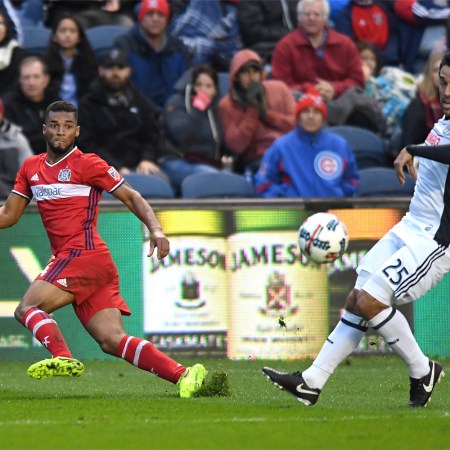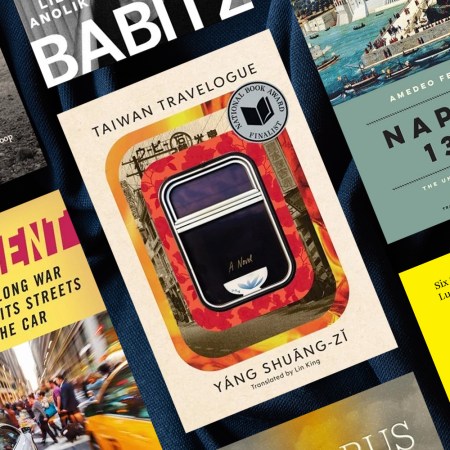What does it take to make a nation a soccer powerhouse? On the men’s side of the sport, only eight national teams have ever won a World Cup; for women, that number is four. But the 21st century might well see a shift in that balance. The United States, whose women’s team has been dominant on the international stage, is in the midst of a major overhaul of its men’s program, with mixed results so far.
But the U.S. isn’t the only massive country with its eyes on international soccer glory. Both China and India have also made significant investments in their own soccer infrastructure — all of which raises the question of whether a massive countries with substantial resources can become a major player in global soccer.
One person who’s spent a lot of time thinking about these questions is David Goldblatt. His earlier book The Ball Is Round: A Global History of Soccer offers readers a sprawling, comprehensive history of soccer across the world. Goldblatt’s latest book, The Age of Football: Soccer and the 21st Century, explores the changes that have occurred in the sport in the early years of this new century.
“The speed and scale of globalization that has shaped football has taken a step upwards in the last 20 years,” Goldblatt says. “When I wrote The Ball is Round, Twitter had not been invented.”
That’s one of several reasons Goldblatt lists for why he’s opted to revisit the sport on a global scale. Among others? The rise of women’s soccer as a global force all its own is one; the rise of China, India and the United States is another. Still another is the way Goldblatt sees sports and politics as inexorably linked.
“A big theme of The Age of Football is that politicians attempt to shape football or take a share of the glory,” he says. “So Mussolini organizes the 1934 World Cup and basks in its glory, and the Argentinian junta has the ‘78 World Cup.”
As Goldblatt notes, this blend of politics and soccer isn’t a new thing. “We’ve been here before,” he says. “But the sheer scale and reach of political power into football, I think, is absolutely unprecedented in the last 20 years.”

The dynamics that Goldblatt establishes in The Age of Football establish a clear connection between political power and soccer. The conclusion is titled “The Global Potemkin Village: World Cup 2018,” and there are plenty of observations about how Chinese investments throughout Africa have included soccer infrastructure like large-capacity stadiums. Goldblatt’s comments also resound when reading about events that have transpired after his book was completed, such as Donald Trump’s friendly relationship with FIFA President Gianni Infantino.
Goldblatt cites a number of global leaders, past and present, with a history of enthusiasm for soccer as either players of fans. Among them: China’s Xi Jinping. “He loves football,” Goldblatt says. “It’s noticeable that on his state tour of Britain, the thing that he said he was most pleased about was not going to Parliament or visiting the Queen at Buckingham Palace and riding in a gilded Victorian carriage, but getting a selfie with Sergio Agüero at the Manchester City training ground.”
Having a high-profile fan of the game in a position of national power had an effect on the way club teams operated within China. “The number-one thing holding Chinese football back,” Goldblatt says, “was the unimaginable amounts of corruption, cheating, match fixing and referee bribing that have been going on for the previous decade — to the point where, despite relaunches and all sorts of attempts to make the game palatable, people were just going, what’s the point?”
“The pretty brutal methods that Xi Jinping has employed in the world of football — reflective of the wider anti-corruption campaign he’s been conducting — have certainly, in football, yielded results,” Goldblatt says. He also cites an ambitious plan from 2016 — in which China set a goal of being one of the world’s best soccer nations by 2050.
The men’s domestic leagues in both China and India have begun to attract high-profile players from around the world — though many of them are in the final years of their careers. Robbie Keane spent time at ATK in India, while the likes of Oscar and Marouane Fellaini are presently playing for teams in the Chinese Super League.
Whether the influx of global stars has had an effect on those countries’ domestic players, however, remains to be seen. When asked if China or India seems close to producing a player capable of starting for a UEFA Champions League-caliber team, comparable to South Korea’s Heung-min Son or Japan’s Keisuke Honda, Goldblatt is skeptical.
“I think we’re really quite some way from that, is my impression,” Goldblatt says. “I mean, if you look at the performance of the Chinese national team as some sort of measure of the caliber of their best players, it’s improving — but it’s still short of Japan and South Korea, where you have had a smattering of players at the leading clubs in Europe.”
His estimate for when that might change? “Ten years,” he says. “Maybe more.”
But for all of the fascinating and sometimes disquieting ways in which soccer and politics have overlapped over the years, Goldblatt’s book offers plenty of grounds for optimism. Might we see the men’s team from China, India or the United States in a World Cup final in the years or decades to come? We’re certainly closer to that than we were before — and it should make for some excellent games down the road.
Whether you’re looking to get into shape, or just get out of a funk, The Charge has got you covered. Sign up for our new wellness newsletter today.
























